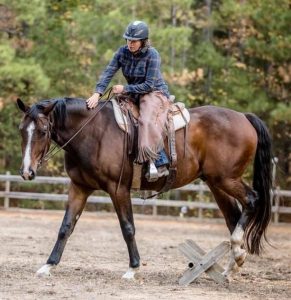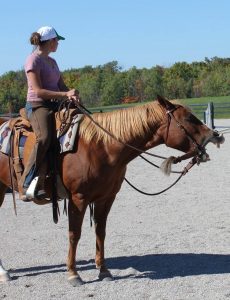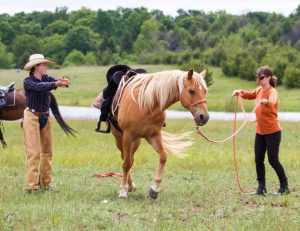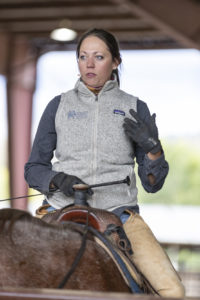
Amy Skinner
Editor’s Note: Amy Skinner is a regular guest columnist and has been a horse gal since age six. She has presented twice at the Best Horse Practices Summit and is the author of To Catch a Horse: Finding the Heart of your Horsemanship.
She rides and teaches dressage and Western. Skinner has studied at the Royal Andalusian School of Equestrian Art in Spain, with Brent Graef, Leslie Desmond, and many others. Visit her website here.
Amy Skinner writes:
Get ready to be surprised.
That’s how I should preface my riding instruction with new students.
One of my students told me: “You bring the opposite of everything I’ve ever learned and it’s constantly weird and surprising.”
That makes me smile and I take it as a compliment. But one of my philosophies gets the most perplexed looks: Use the horse’s resistance and make it beautiful. Stop trying to make them not resist.

Amy’s horse, Dee, relaxes during a clinic.
I experience this issue with students frequently when it comes to their horses wanting to drift to the gate or refusing to go into the scary parts of the arena. The riders’ instinct is to wage war. They need to either push the horse into the scary areas or force them away from the gate, or “make the wrong thing hard” by working them harder in areas they try to go.
These tactics are excessively confrontational. They may work in the short term, but the side effects make it the wrong way to solve a problem.
Say you get your horse off the gate with heavy leg and rein aids. It’s worked. But what did the horse learn? Heavy leg and rein aids are required, and they should resist you until they ultimately concede. At this moment, most riders stop riding. Their seat becomes stiff while their hands go to work. This causes the horse’s back to stiffen, making staying at the gate, in fact, the easiest thing for the horse. You end up building a braced horse, a resentful horse, a distrusting horse.
Many horses while being pulled away from a gate learn to add power to their underneck and shoulders to be used against the inside rein. In the end, if the horse does go away from the gate, their mind and body are not working together. You may get a mechanical response, not a soft one.
 The ‘make the wrong thing hard’ approach is a bit more baffling to me. My first questions to students are:
The ‘make the wrong thing hard’ approach is a bit more baffling to me. My first questions to students are:
- Why would you want to make work a punishment?
- If rest is the reward and work is the aversive, at what point does that backfire when you go back to (good) work?
- Why would what you ask a horse to do be unpleasant one minute, then when you’ve move on from the gate, say, magically become pleasant again?
- Why is it kinder to operate under the threat of more work than to simply force the horse to do what you want in the first place?
- With both tactics, even if you get what you want, how much time did you spend with a tight, imbalanced, braced, confused, or unhappy horse?
- Why are those ways of riding worth doing if you have alternatives?
My goal with every horse is to make work pleasant, to build a balanced, happy horse, and to set them up for success in each situation as much as possible. That means:
- Look at the overall picture.
Why does your horse want to go to the gate, and why doesn’t he want to go into the corners? Maybe the issue is your relationship, the way you ride, your idea of arena work, or your horse’s understanding of the aids.
The horse may benefit from an arena break altogether. There are so many possibilities here, but often the problem we get stuck on is not the problem at all, but a symptom of a larger problem.
- Preparation.
The horse may benefit from being hand-walked into the scary areas and learn to relax there. The horse might not understand how to get straight and is just looking for something to lean toward, and the gate is an easy draw. More groundwork and in-hand work might be needed.
- If you’re prepared and have considered the Big Picture, then take the horse’s resistance and make it productive and beautiful.

Amy Skinner at the BHPS 2018
If my horse avoids a corner, that is a perfect place to teach shoulder out or leg yield away from that corner.
If the horse is green, I can use those areas to begin preparation work for lateral movements, of riding a large circle but on a counter bend. In this way, we are moving away from the scary areas but with purpose. Not only do I get to use their natural movement to teach something easily, they can become straighter and more supple because of it.
Eventually as we pass these areas in the arena, they become less and less concerned and more focused on the work. Soon enough, these areas are not a problem at all, and we can leg yield wherever we want.
As for sticking to the gate: this is an excellent opportunity to improve your horse’s understanding of rhythm. I normally focus where I intend to move toward as I relax my reins, keep the rhythm in my body and ask the horse to maintain the rhythm, too.
When ridden correctly, a horse in rhythm not only cannot stick at the gate, but in feeling more secure, he begins opening up his shoulders. Best of all, he is directed by not fighting with the rider. Everyone wins.
People think of these strategies as “letting the horse get away with things.” I don’t see horses ridden this way as getting away with things, but rather learning to trust their rider who consistently directs with fairness, prepares them well, provides a good feeling in all work, and makes the horse better physically and mentally with each ride.